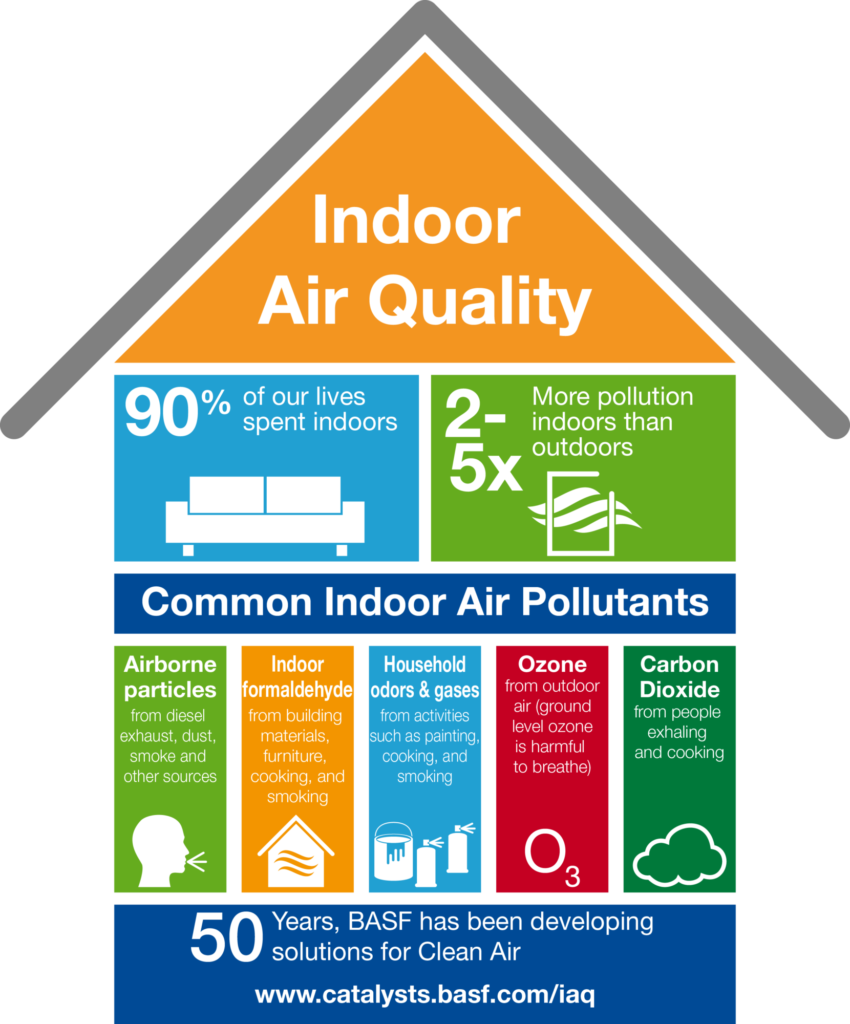Indoor air quality is a critical aspect of our overall well-being, influencing not just our comfort but also our long-term health. Poor indoor air can lead to several health effects, including respiratory issues, headaches, and decreased cognitive function, making it essential to ensure a clean environment. With most people spending upwards of 80% of their time indoors, the impact of indoor pollution has never been more relevant. Effective building ventilation systems play a key role in improving air quality and filtering harmful contaminants. Understanding and addressing these factors can help create healthier buildings that promote wellness and productivity.
When discussing the environment within our homes, workplaces, and schools, we often refer to it as ‘indoor environmental quality’ or ‘indoor climate.’ These terms encapsulate various elements such as air cleanliness, lighting, and temperature control that collectively affect our health and comfort. The significance of maintaining a healthy indoor climate cannot be overstated, as it directly impacts our cognitive abilities and overall productivity. Moreover, ensuring adequate air flow and minimizing pollutants inside buildings is crucial for enhancing our quality of life. As we delve into the importance of these indoor settings, it’s essential to recognize how they influence our daily experiences and long-term health outcomes.
Understanding Indoor Air Quality
Indoor air quality (IAQ) is a critical factor that influences our health and wellbeing, particularly since many individuals spend around 90% of their time indoors. Poor IAQ can lead to a host of health issues, ranging from allergies to respiratory problems, exacerbated by indoor pollutants such as mold, dust, and chemicals from household products. These pollutants can accumulate in offices, schools, and homes, significantly detracting from the overall quality of life. Hence, it is vital to examine the elements that contribute to optimal indoor air quality and implement necessary improvements to mitigate these risks.
Additionally, indoor air quality isn’t just about reducing pollutants; it encompasses effective building ventilation and the management of humidity levels. Enhancing air circulation can dilute toxic contaminants and bring fresh outdoor air indoors. By integrating advanced ventilation systems and periodic air quality assessments, we can create healthier indoor environments that promote better concentration and overall cognitive function. This is particularly important in workplaces, where enhanced IAQ has been linked to increased productivity and employee satisfaction.
The Health Effects of Indoor Pollution
Indoor pollution can have serious health effects, particularly on vulnerable populations such as children, the elderly, and individuals with pre-existing health conditions. These effects can manifest as respiratory illnesses, headaches, fatigue, and cognitive impairments. For example, research indicates that inadequate ventilation can not only increase airborne illnesses but also hinder mental performance by impacting cognitive function and focus. Over time, the cumulative impact of poor indoor air quality can diminish quality of life, leading to chronic health issues that may require medical intervention.
Moreover, the sources of indoor pollution often stem from everyday activities. Common household items such as cleaning agents, paints, and even furniture treatments release volatile organic compounds (VOCs) that contribute to air quality degradation. The limited knowledge about these pollutants and their long-term effects heightens the importance of awareness, allowing individuals and organizations to take proactive measures towards maintaining a healthy indoor environment. Solutions such as adopting green building practices and utilizing low-VOC materials can significantly enhance indoor air quality.
Building Ventilation: A Key Component of Healthy Spaces
Effective building ventilation plays a crucial role in maintaining good indoor air quality. As indoor air pollutants accumulate, proper ventilation ensures that stale air is exchanged for fresh air, thereby reducing concentrations of harmful substances. This practice not only benefits general health but is also essential to cognitive function, as multiple studies have shown that enhanced air circulation in workspaces elevates employee performance and creativity. Consequently, optimizing building ventilation systems is a fundamental step towards creating healthier environments that support both physical and mental well-being.
Additionally, improving building ventilation can also reduce the spread of infectious diseases within indoor spaces. During disease outbreaks, ensuring adequate airflow becomes even more critical. By strategically designing ventilation systems that draw in outdoor air and increase filtration rates, buildings can substantially lower disease transmission risks. Thus, adopting comprehensive building ventilation strategies not only safeguards occupants’ health but fosters a productive and safe atmosphere for working and learning.
Cognitive Function and Indoor Environments
The relationship between indoor environments and cognitive function is increasingly recognized in public health discussions. Researchers have found that individuals working in spaces with proper air quality and ventilation perform better on cognitive tasks and experience fewer cognitive decline issues. Impaired air quality, often derived from pollutants and inadequate ventilation, undermines cognitive abilities, leading to errors and reduced productivity in professional settings. Therefore, by prioritizing healthy building strategies that enhance IAQ, organizations can nurture a more capable workforce.
Moreover, the impact of environmental factors on mental acuity extends to academic settings. Students exposed to improved indoor air quality exhibit better performance in concentration and learning abilities. Educational institutions that adopt health-centered building practices not only enhance student performance but also support a vibrant learning atmosphere. It is imperative to advocate for guidelines that emphasize the importance of maintaining high-quality indoor environments in order to protect and elevate cognitive function among all age groups.
Strategies for Creating Healthy Buildings
Creating healthy buildings involves numerous strategies that prioritize indoor air quality and reduce the impacts of indoor pollution. This can be accomplished through the careful selection of building materials, implementation of ventilation systems that ensure adequate air exchange, and regular maintenance to remove dust and allergens. Furthermore, utilizing air purification technologies, such as HEPA filters, can significantly minimize the presence of harmful particles, enhancing the overall health of the indoor environment.
Additionally, integrating biophilic design elements—such as greenery and natural lighting—can not only improve aesthetics but also support occupant wellbeing. These designs help to mitigate stress and improve mood, further contributing to a healthier indoor environment. By fostering healthier buildings, we empower individuals to thrive in an environment where their health and productivity are prioritized, leading to healthier communities overall.
Frequently Asked Questions
What is indoor air quality and why is it important for health?
Indoor air quality (IAQ) refers to the condition of the air inside buildings and its impact on occupants’ health and comfort. Poor IAQ is linked to indoor pollution, which can cause health effects such as headaches, fatigue, and respiratory issues. Maintaining healthy air quality is essential for overall well-being, especially in environments where people spend a significant amount of time.
How does indoor pollution affect cognitive function in workplaces?
Studies show that indoor pollution can significantly impair cognitive function. High levels of pollutants can reduce concentration, decision-making skills, and overall productivity in workplaces. Improving building ventilation and reducing indoor pollution are key strategies to enhance cognitive performance among employees.
What role does building ventilation play in maintaining good indoor air quality?
Building ventilation is crucial for ensuring healthy indoor air quality. It helps to reduce indoor pollution by allowing fresh outdoor air to circulate and removing stale air and contaminants. Proper ventilation has been shown to improve overall health effects and enhance cognitive function in building occupants.
Can you improve indoor air quality in older buildings?
Yes, improving indoor air quality in older buildings is possible through various methods such as upgrading ventilation systems, using air purifiers, and regularly maintaining HVAC systems. These changes help reduce indoor pollution and enhance the health of residents and employees.
What are some common sources of indoor pollution?
Common sources of indoor pollution include tobacco smoke, mold, dust mites, pet dander, and volatile organic compounds (VOCs) from paints and cleaning products. Reducing exposure to these pollutants is essential for improving indoor air quality and preventing health issues.
How can increased ventilation improve indoor air quality in schools?
Increased ventilation in schools can significantly improve indoor air quality by diluting and removing airborne contaminants, thereby decreasing the risk of respiratory illnesses and enhancing students’ cognitive function. Proper air exchange rates contribute to healthier learning environments.
What simple actions can homeowners take to improve indoor air quality?
Homeowners can improve indoor air quality by ensuring good ventilation, using air purifiers with HEPA filters, regularly cleaning and decluttering, and choosing low-VOC products. These actions help reduce indoor pollution and create a healthier living space.
How does indoor air quality affect children’s health?
Indoor air quality has a significant impact on children’s health. Poor IAQ can lead to respiratory problems, allergies, and developmental issues. Prioritizing healthy buildings with good ventilation and low indoor pollution levels is essential for promoting optimal health outcomes for children.
Is it possible to manage indoor pollution in multi-unit residences?
Yes, managing indoor pollution in multi-unit residences is important and can be achieved through increased ventilation, use of air purifiers, and air quality assessments. Strategies such as sealing gaps and maintaining shared spaces can also reduce the transfer of indoor pollutants from one unit to another.
What long-term strategies can organizations implement to enhance indoor air quality?
Organizations can develop long-term strategies for enhancing indoor air quality by investing in upgraded HVAC systems, conducting regular air quality assessments, implementing green building practices, and promoting employee awareness about maintaining a healthy indoor environment.
| Key Points | Details |
|---|---|
| Impact of Indoor Air Quality | Indoor air quality significantly affects health, concentration, and cognitive functions. |
| Quiz Insights | A quiz developed based on research helps understand the importance and effects of indoor air quality. |
| Health Risks | Poor indoor air can lead to tiredness, concentration issues, and increased risk of illness. |
| Building Ventilation | Increasing air ventilation in buildings can improve cognitive function significantly. |
| Chemical Safety | Out of over 80,000 commercial chemicals, only a few have been banned since 1976, raising concerns about indoor exposure. |
Summary
Indoor air quality is crucial for maintaining health and well-being, as demonstrated by its significant impact on cognitive function and the overall health of individuals. Studies reveal that the air we breathe indoors can carry pollutants and pathogens that may lead to unexpected health issues. By prioritizing improvements in indoor environments through enhanced ventilation, better filtration systems, and awareness of chemical safety, it is possible to create healthier indoor spaces that support our physical and mental health.









